A bunch of little gems found in The Club Hotel, Limited: Guide Book of Yokohama, Tokyo and Principal Places in Japan, printed at the “Box Of Curios,” No. 58, Main Street, Yokohama, Japan. There’s no copyright or publication date, but the book is circa 1880s to 1910s.
The people who stamp about the streets playing a double whistle are blind Shampooers, i.e. “Massage” operators by trade.
Japanese baths are generally heated with charcoal, and it is well to be careful of asphyxia from the fumes. The bath-houses with men and women bathing in full sight of each other, are a curiosity to Europeans.
This idea of co-ed bath-houses, or at least visibility in Japanese bath-houses, contradicts everything we think we know about Japanese modesty, i.e. the information on this antique, circa 1915, lantern slide literature piece:
The woman is taught from girlhood to be modest, retiring and obedient as daughter and wife, and as a rule she is almost certain to avoid spinsterhood, so well-planned is the marriage machinery in Japan. Courtship is unknown as we know it. The bringing about of marriages regularly the work of a private go-between, who brings the young people together after the parents on both sides, with additional precautionary inquisitorial go-between, have agreed to a proposed match. Thus girls often select their husbands unknown to the bridegroom himself, for the selection is usually supposed to be and usually is the result of the go-between’s astute observation, the initiative coming from one or the other parents, who says in effect, ‘Pray you good friend, find a spouse for my daughter– or son” as the case may be. In this way even when a young man or young woman has a small purse or a bodily defect some one equally short in cast or corporal perfection is found and the thing is done. The young people meet at a theater or feast; they chat gingerly with each other and final consent is given. No courtship and absolutely no kissing!’
Listed on the same page of this antique Japan travel guide as Japanese Wrestling, Public Libraries, Museums, Places Of Worship — and across from the small map of the Temples of Shiba — are the Geisha or Singing girls, which could be ordered through the tea-house.
In materials associated with this1915 lantern slide of geisha girls, there is more detail on the hiring of the women:
The geisha houses, rather humble, certainly unpretentious abodes, group themselves in certain quarters, and the hiring of the girls is done methodically through a central office. The hiring should be accomplished by the restaurant keeper or by the housewife as early in the afternoon as possible, but not after six in the evening, unless absolutely unavoidable. For the preparation of the Geisha is an elaborate affair from the wonderful coiling and adorning of her hair to the fit of her white, heelless shoes. They are taken in rickishas to the house of entertainment and carried home in the same way when all is over.
In Chapter V, day trips in the area surround Tokyo, Geisha girls — “pleasure boats full” — are also mentioned.
Information on another antique lantern slide depicting a geisha:
The geisha or singing girl to the “Western” mind fills out the romantic ideal of modern Japan. To the native she is simply a sublimated waitress with dancing and singing trimmings, but she is also a chosen vehicle of Japanese romance. Visions of her dressed in showy silken robes waving a large fan, her black hair marvelously coifed, a fixed smile on her face and moving in rhythmic steps with a special flowing elegance of gesture, rise before those who have seen her at her high functions. Ever to the accompaniment of the tinkling strings of the of the samisen and the full beat of the tsuzumi that picture comes back to the foreigner as the flower of his reminiscence of Japan.
The 14th day, suggests the “opportunity of witnessing the theatres,” of which “Danjuro is admittedly the best actor in Japan.” This 1915 lantern slide is presumably the man himself; likely a descendant of this Danjuro.
And the 15th day one must go to the Bazaar in Shiba Park to “see the gamour dancing girls at the Maple Club, (Koyo Kwan) for which you must obtain an introduction from a member, and afterwards go to the No Dances, a kind of ancient opera, held in the immediate vicinity.”
According to Queer Things About Japan, by Douglas Brooke Wheelton Sladen, 1904:
The most the ordinary globe-scorcher has to say for Japanese theatres is that they please the Japanese — common Japanese. The good-class Japanese do not go to them. They go in for No-dances, which strike the scoffing European as very well-named; not being dances at all, but a sort of religious play, with posturing and singing and declamation.
Additional information that accompanies this lantern slide:
The Japanese love the theater, and it is a thoroughly national institution. You will be told in select circles how up to the Restoration in 1868 the theater was looked down on, and actors in the view of the samurai class were beneath contempt– the offensive manifestants of a degrading kind of exhibition. There was, no doubt, much affectation in this. The popular theater was supposed to clash with the traditions of the Japanese classic drama know as the “No or “No Dance”.
Today there are hundreds of theaters giving popular drama. The “No” is a collection of some two hundred and thirty-two dramatic episodes, mostly tragic, which were collected and given permanent form in the early fifteenth century.
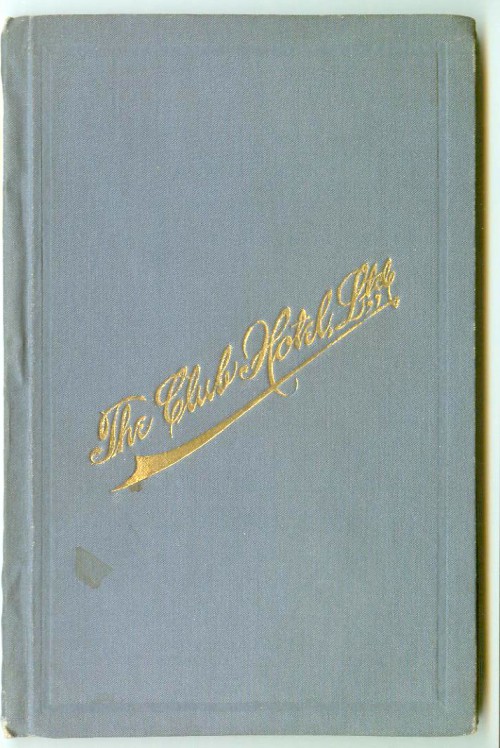
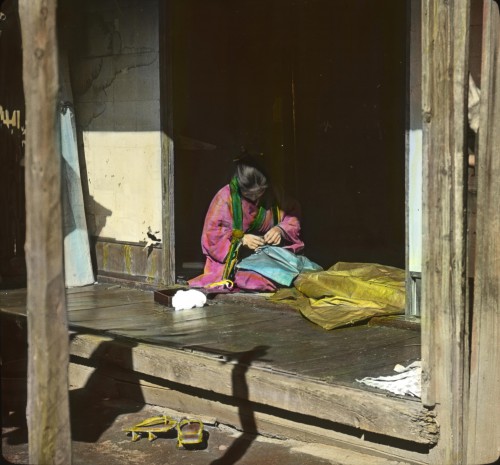
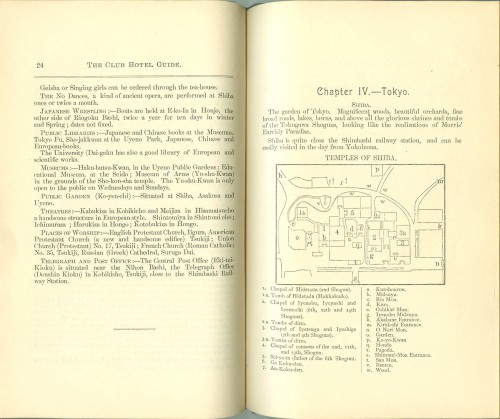
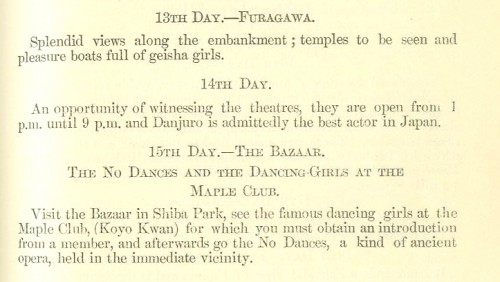
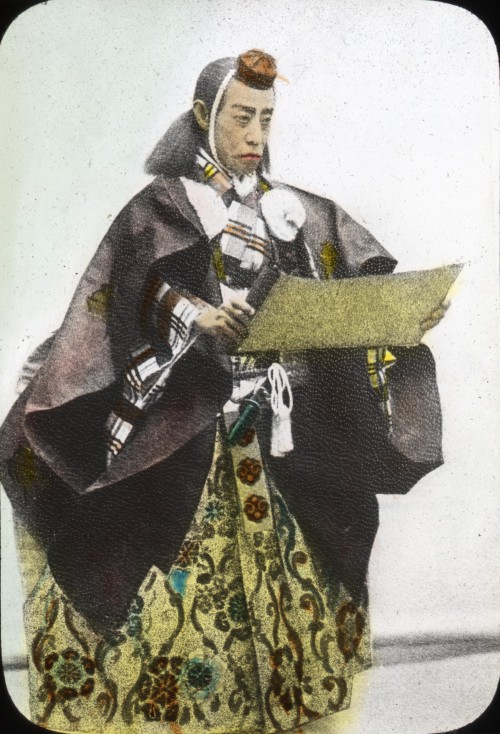
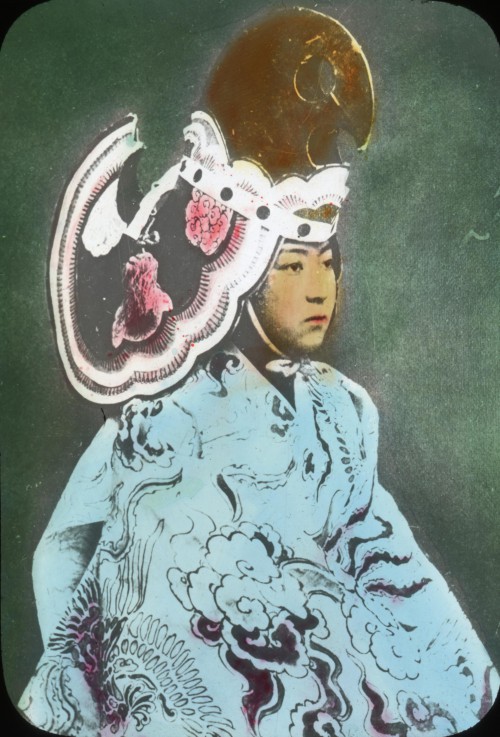
2 Comments